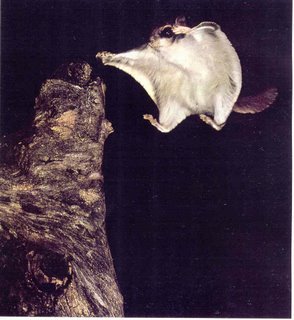The Northern Flying Squirrel—Endangered

Image: A northern flying squirrel as it lands from a glide. (National Geographic Society 1979)
The Northern Flying Squirrel (Glaucomys sabrinus) is one of two species of the genus Glaucomys, the only flying squirrels found in North America (the other is the somewhat smaller Southern Flying Squirrel, G. volans). Two subspecies are found in the southern Appalachians, the Carolina Northern Flying Squirrel, G. s. coloratus, and the Virginia Northern Flying Squirrel G. s. fuscus, both of which are endangered.
These squirrels are small nocturnal creatures that spend most of its time in trees. They have large black eyes, rounded ears, and long whiskers. Their soft fur varies in shades of gray and brown, and their belly is mostly white but lead colored at the base. The northern flying squirrel has a flight membrane called a patagium that extends from their hands to their feet. Their patagium is elastic and retractable, allowing them to be nimble when they are running or climbing. When they glide, they stretch out their limbs so their patagium looks like a sail, and then they jump off the branch and use their body to maneuver themselves in the air. So they don’t fly the way a bird does, but they can glide well over 100ft. or about 30m. The northern flying squirrel has a flattened tail that is 40 percent of their total body length. The fur on their tails is very short on the top and bottom and long and flattened on the sides. Their tails acts like a stabilizer and a rudder when they are gliding which also aids them in landing.
Northern flying squirrels molt once a year in autumn. They are clean animals and spend part of their day grooming. Their active period is pretty short, just a couple of hours after sunset and the last hour or so before sunrise. They have a call that is typical for squirrels a “chuck-chuck,” but sometimes they chirp notes like a bird. Their main predator is the Great Horned Owl, but the bobcat, fox, and hawk are also predators of concern for them.
They are found mainly in coniferous forests, but can also be found in deciduous and mixed coniferous and deciduous forests. Common nests for the squirrels are abandoned woodpecker nests or a hollow of a tree. They may insulate their nests first with leaves, dried grass, and then add shredded vegetation, feathers, fur, dried grass, or lichen.
The northern flying squirrel has a typical squirrel diet, which consists of a variety of foods such as seeds, nuts, berries, some leaves, buds, mushrooms, acorns, flowers, fruits, fungi, lichen, sap, insects and sometimes bird’s eggs. Unlike regular squirrels, lichen and fungi makes up a large portion of the flying squirrels’ diet. Northern flying squirrels have been known to hoard food for the winter months, although they do not hibernate.
The mating season starts at the end of March and the beginning of April. It is common for the male to be driven off by their mate before their young are born, but usually they stay near their family by having a nest close by. The female northern flying squirrel is territorial, whereas the male is not. At night the adults may feed and play together, but there is no evidence that the males ever get to be with their offspring. The squirrels give birth in late April to June, and one litter is born a year. The average litter size is three, but the range is from as little as one to as many as six. The gestation period is 37-42 days, and the newborns are deaf, blind, and hairless and weigh about 5-6 grams. In about a month they have grown some fur, and may weigh four times as much as when they were born. At about nine weeks they are weaned becoming more independent. By the twelfth week they try gliding. At four months they become good gliders and are able to take care of themselves. The northern flying squirrels survival rate is less than thirty percent for juveniles and fifty percent for adults. The average life span is about 3-4 years but some in captivity may live as long as 10 years. There is little known about the squirrels’ social structure, courtship, mating and reproductive behavior since they are nocturnal and may be hard to spot.
Technorati Tags: [Blue Ridge][Northern Flying Squirrel][North America][Virginia][North Carolina][West Virginia][Endangered][squirrels][wildlife]

0 Comments:
Post a Comment
<< Home